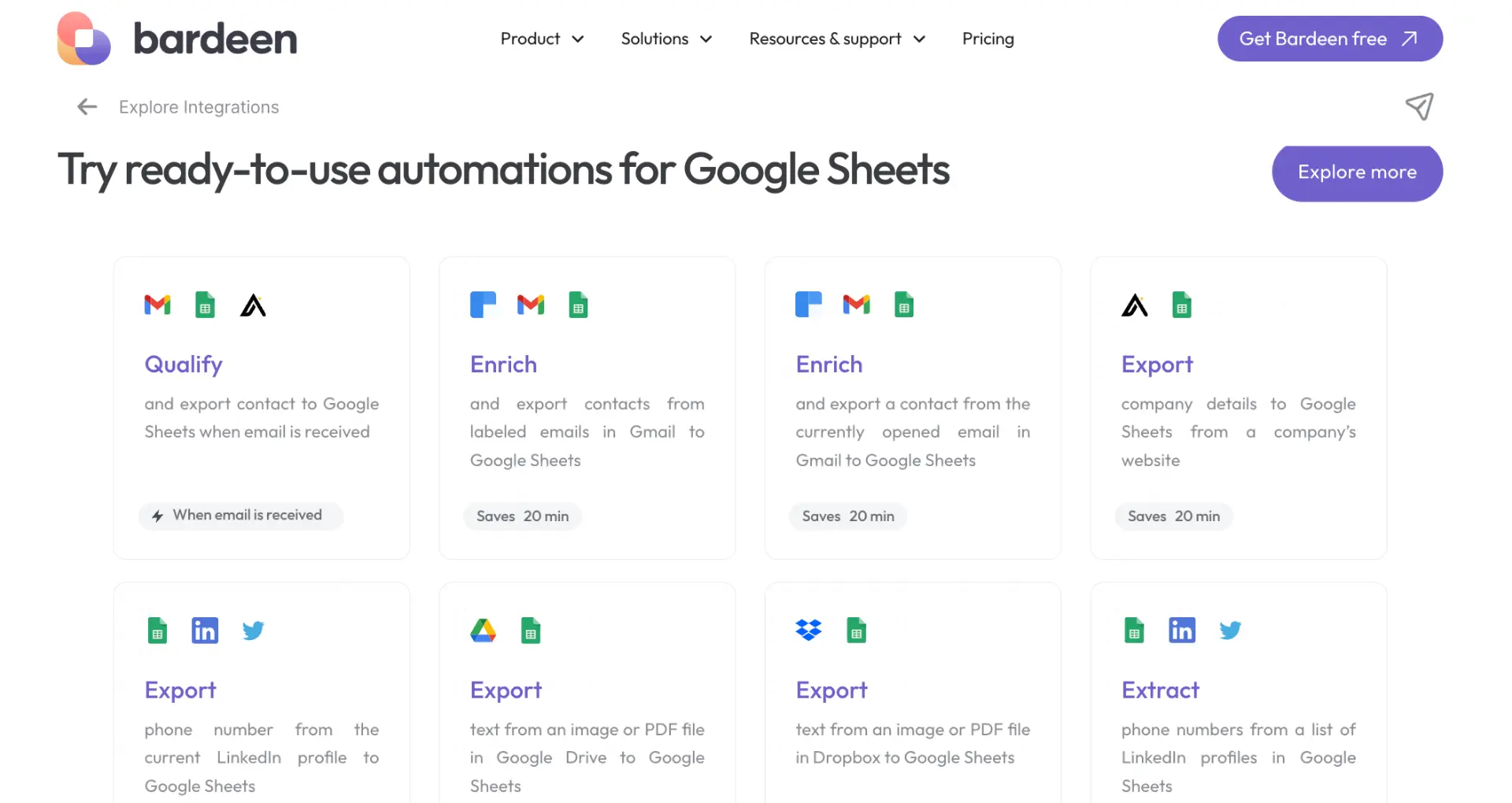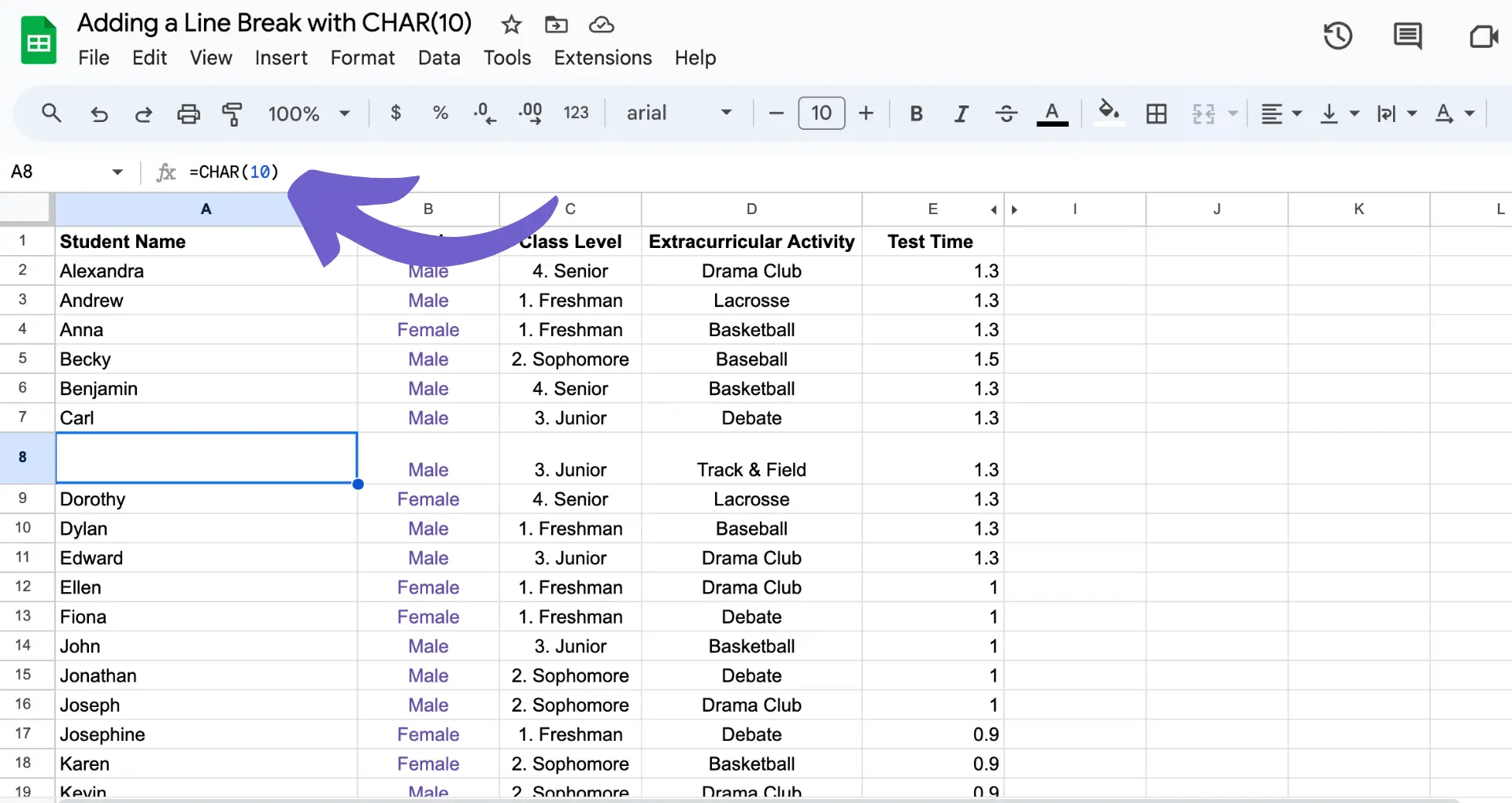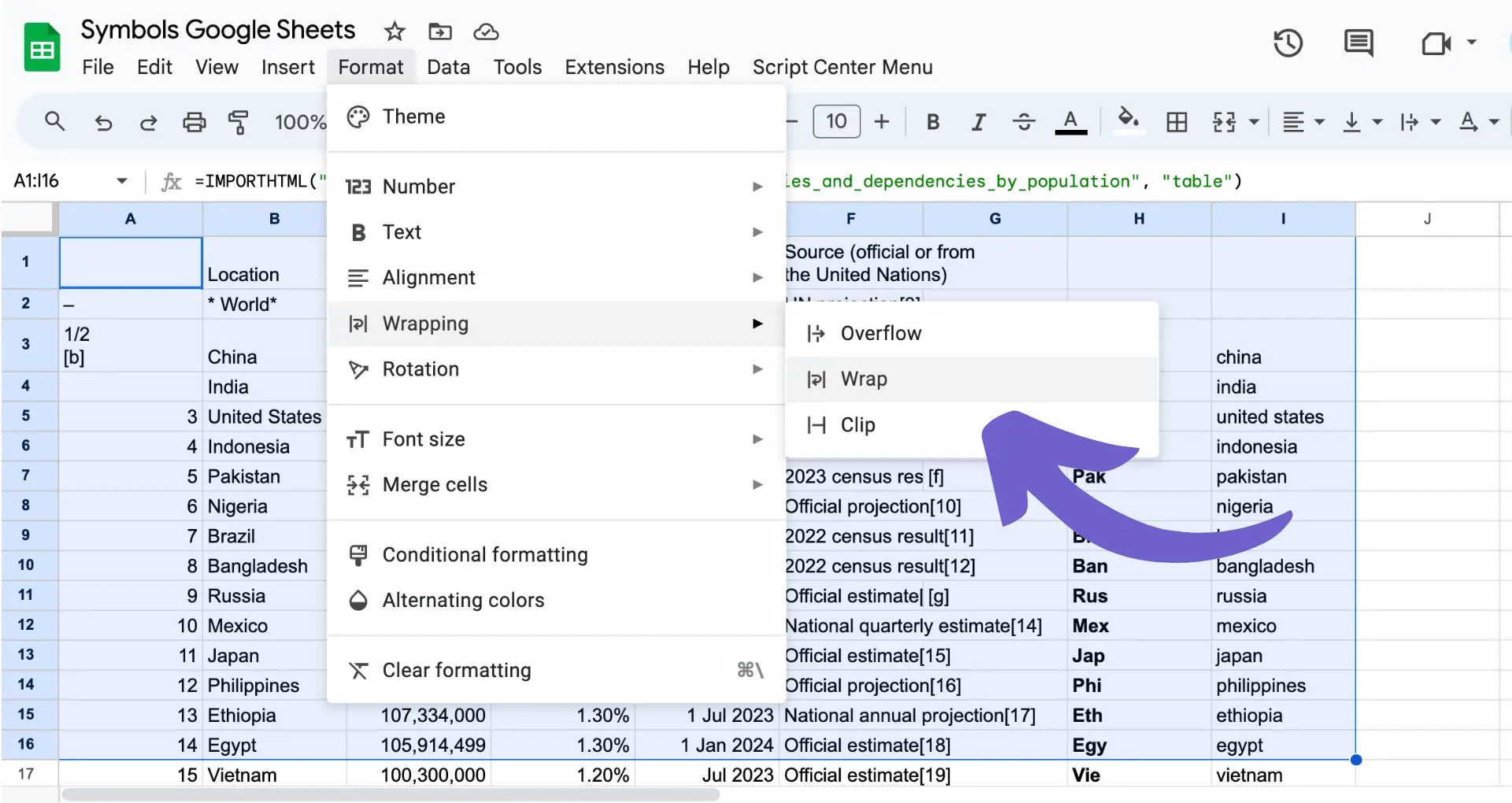Press Ctrl+Enter (Windows) or ⌘+Return (Mac) to add a newline.
By the way, we're Bardeen, we build a free AI Agent for doing repetitive tasks.
If you're working in Google Sheets, you might love our GPT in Spreadsheets feature. It can automate tasks and improve your workflow.
Adding line breaks in Google Sheets cells can significantly improve the readability and organization of your data. In this step-by-step guide, we'll explore various methods to insert new lines within cells, including using keyboard shortcuts, the CHAR(10) function, and incorporating line breaks in formulas. By mastering these techniques, you'll be able to create well-structured and visually appealing spreadsheets that are easier to understand and maintain.
Introduction to Line Breaks in Google Sheets
Line breaks play a crucial role in organizing and presenting data effectively in Google Sheets. By allowing you to split text within a single cell, line breaks enhance readability and make your spreadsheets more visually appealing. Unlike traditional text editors like Google Docs, where pressing the Enter key creates a new paragraph, Google Sheets requires specific techniques to insert line breaks within cells.
Bardeen can automate tasks that involve adding data with line breaks to Google Sheets, saving you time from manually copying and pasting information:
In this guide, we'll explore the significance of using line breaks in Google Sheets and compare their functionality to other text editing tools. By mastering the art of inserting line breaks, you'll be able to:
- Improve the overall structure and readability of your data
- Create well-organized lists within individual cells
- Enhance the visual appeal of your spreadsheets
- Efficiently utilize space and maintain a clean layout
Whether you're working with addresses, product descriptions, or any other multi-line data, understanding how to insert line breaks in Google Sheets is an essential skill for effective data management. You can also bring AI into your spreadsheet to automate and enhance your workflow.
Using Keyboard Shortcuts for Line Breaks
One of the quickest and most convenient ways to insert line breaks in Google Sheets is by using keyboard shortcuts. These shortcuts vary depending on your operating system:
- Windows: Press Ctrl + Enter or Alt + Enter while editing a cell to create a new line.
- Mac: Press ⌘ + Return, Option + Return, or Control + Return to insert a line break within a cell.
To use these shortcuts, follow these step-by-step instructions:
- Double-click on the cell where you want to insert a line break.
- Place your cursor where you want the line break to appear.
- Press the appropriate keyboard shortcut for your operating system (e.g., Ctrl + Enter for Windows or ⌘ + Return for Mac).
- Continue typing on the new line or press Enter to save your changes and exit the cell.
By using these keyboard shortcuts, you can quickly add line breaks to your cell content, making it easier to read and organize. This technique is particularly useful when working with addresses, multi-line product descriptions, or any other data that benefits from clear separation between lines.
Bardeen's Google Sheets integration can help you save even more time by automating data entry and formatting. Try these playbooks to automatically copy data with line breaks from various sources:
For more tips on how to connect Google Sheets with other apps, check out our integration resources.
Save time on repetitive tasks in Google Sheets by using Bardeen's Google Sheets integration. Automate your workflows without coding and make your data work for you.

Utilizing the CHAR(10) Function for Line Breaks
The CHAR function in Google Sheets allows you to insert specific characters into a cell using their character codes. To insert a line break, you can use the CHAR(10) function, as the character code for a new line is 10.
Here's how to use CHAR(10) in your formulas to combine data from multiple cells with line breaks:
- In a new cell, type an equals sign (=) to begin your formula.
- Type "CHAR(10)" (without quotes) to represent a line break.
- Use the ampersand (&) to concatenate the CHAR(10) function with your cell references or text strings.
- Press Enter to complete the formula and see the result with line breaks.

For example, to combine the values from cells A1, B1, and C1 with line breaks between each value, use the following formula:
=A1&CHAR(10)&B1&CHAR(10)&C1
This formula will display the value from A1, followed by a line break, then the value from B1, another line break, and finally the value from C1.
Bardeen can help automate importing data from various sources into Google Sheets, saving you time from manual data entry:
By incorporating the CHAR(10) function into your formulas, you can create more readable and organized cell content that spans multiple lines. For more advanced spreadsheet tasks, consider using GPT in Google Sheets.

Bardeen can also help keep your Google Sheets data up-to-date by enriching existing rows or adding new rows when records are created in other tools:
Inserting Line Breaks in Google Sheets Formulas
When working with lengthy or complex formulas in Google Sheets, adding line breaks can significantly improve clarity and maintainability. By inserting line breaks, you can make your formulas more readable without affecting their functionality.
To add a line break within a formula, follow these steps:
- Double-click the cell containing the formula to enter edit mode.
- Place your cursor where you want to insert the line break within the formula.
- Press Ctrl + Enter (Windows) or Command + Return (Mac) to add the line break.
- Continue editing your formula as needed, adding more line breaks for improved readability.
- Press Enter to complete editing the formula.
Here's an example of a complex formula with line breaks added for clarity:
=IF(A1>10,
"High",
IF(A1>5,
"Medium",
"Low"
)
)
In this example, the line breaks make it easier to understand the nested IF statements and their corresponding values. Remember, the line breaks do not affect the formula's calculation; they only serve to make it more readable for you and others who may need to understand or modify the formula in the future.
After adding line breaks to improve formula readability, you can use Bardeen to automate tasks related to working with data in Google Sheets. This will save you time and reduce errors. Try these playbooks:
For more advanced use, you can also add AI to your Google Sheets to improve productivity.
Save time on repetitive tasks in Google Sheets by using Bardeen to connect Microsoft Excel and streamline your spreadsheet workflows effortlessly.
Enabling Text Wrapping to Handle New Lines
While inserting manual line breaks allows you to control exactly where new lines appear within a cell, enabling text wrapping in Google Sheets provides a more automatic way to handle lengthy cell content. When you enable text wrapping, Google Sheets will automatically adjust the cell's height to display all the content within the cell's width, creating new lines as needed.
To enable text wrapping, follow these steps:
- Select the cell or range of cells you want to wrap.
- Click on the "Format" menu in the top navigation bar.
- Hover over "Wrapping" in the dropdown menu.
- Choose "Wrap" from the submenu that appears.

Alternatively, you can access the text wrapping option from the toolbar below the top menu. Simply select the cell or range, then click the text wrapping icon (a diagonal arrow within a square) and choose "Wrap" from the dropdown menu.
Bardeen can help automate getting text content from various sources on the web into your Google Sheet, saving you time from manually copying and pasting:
Once text wrapping is enabled, Google Sheets will automatically create new lines within the cell to ensure all content is visible without overflowing into neighboring cells. The row height will adjust to accommodate the wrapped text, making your spreadsheet more readable and organized.
Use text wrapping when you have lengthy cell content that doesn't require manual control over line breaks, and you want to maintain a clean, easy-to-read layout. Reserve manual line breaks for situations where you need to control precisely where new lines appear within a cell's content.
Bardeen can also enrich or translate the text before adding it to your sheet. Try these playbooks:
For more advanced Google Sheets tasks, check out how to enrich LinkedIn profiles directly in your spreadsheet.
Troubleshooting Common Issues with New Lines in Google Sheets
When working with new lines in Google Sheets, you may encounter some common issues that can affect your spreadsheet's formatting and readability. Here are a few problems you might face and their solutions:
- Unwanted line breaks in cells: If you notice extra line breaks appearing in cells when you press Enter, Tab, or click away from the cell, try disabling the "Autocomplete" feature in the "Tools" menu. If the issue persists, it may be browser-related. Try using a different browser, such as Google Chrome, to see if the problem resolves.
- Formula parsing issues: When adding line breaks within formulas for better readability, ensure you use the correct key combination (Ctrl+Enter on Windows or Cmd+Enter on Mac) to create the line break. If you accidentally use Enter, the formula may break or return an error.
- Text alignment problems: If your cell content doesn't align correctly after adding line breaks, try adjusting the vertical alignment. Select the cell or range, click on the "Format" menu, hover over "Align," and choose "Middle" or "Bottom" to better suit your needs.
Use Bardeen to AI email organizer and focus on important tasks while automating tedious chores.
If these solutions don't resolve your issues, consider using helper columns or Google Apps Script functions as workarounds. For example, you can use a separate column to concatenate values with line breaks using the CHAR(10) function, or create a custom script to automatically format cells with line breaks based on specific criteria.
Remember to report persistent bugs or issues through the "Help" menu in Google Sheets, as this helps the development team prioritize and resolve problems more effectively.
Automate Google Sheets with Bardeen's Smart Playbooks
Inserting a newline within a cell in Google Sheets can significantly enhance the readability and organization of your data. While this can be done manually, automating tasks within Google Sheets can save time and increase efficiency. With Bardeen, you can take automation a step further by integrating Google Sheets with other tools and services, streamlining your workflow and data management processes. Here are a few examples of how you can automate tasks in Google Sheets using Bardeen's playbooks:
- Enrich and update leads from a Google Sheet, when new row is added [Beta]: Automatically enrich lead information in Google Sheets using email addresses and Apollo, then update the sheet with all the results, even if your local machine is turned off. Ideal for sales teams looking to keep their lead data up-to-date without manual input.
- Save data from the Google News page to Google Sheets: Extract the latest news from Google News directly into your Google Sheets. Perfect for marketers, researchers, and anyone needing to keep up with current events or industry trends.
- Create a ClickUp comment to a task when a Google Sheets spreadsheet is modified: Keep your project management in sync with your data. Automatically create a comment in ClickUp tasks when your Google Sheets spreadsheet is updated, ensuring your team is always informed of the latest changes.






.svg)
.svg)
.svg)
